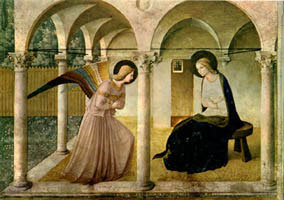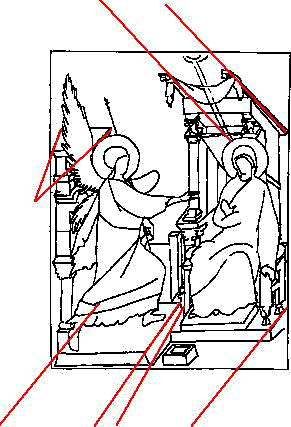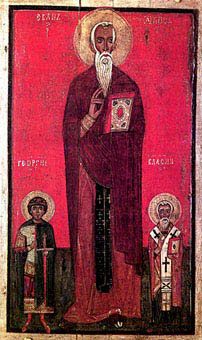|
|
.Inverse or Byzantine perspective is frequently but not exclusively used in the painting of icons. With this form of perspective the viewer is the point of view of the objects in the icon and experiences multiple point of perspective. The intent of using this form of perspective is to allow the viewer a window into the Kingdom of God and to bring them into relationship with the Almighty. This is not a world of science fiction or fantasy rather it represents our world here on earth that has been restored and transfigured by the uncreated light of the Divine. In choosing to not use the illusion of linear space nor of external light and shadow and by placing the point of perspective on the viewer the Divine spills out and over the confines of the frame and rushes out to embrace the heart of man. This form of perspective is very different from the perspective found in Western European art and challenges the cultures way of seeing art.
|
Linear perspective
|
 |
 |
Linear perspective, which was introduced in the Thirteenth and Fourteenth centuries, is constructed with great geometric precision. This is illustrated in the wall painting of the Annunciation by Fra. Angelico that is in the cloister of San Marco in Florence. Here even the architectural details are used to create this type of space. The space that is created lends to the figures a peaceful and harmonious sense of "presence", yet the environment that they stand in is closed. The vanishing point is situated at the small window which drawn the attention of the viewer into the picture. The viewer must "enter into" the picture in order to witness the beauty of the event.
|
Perspective in icons
|
 |
 |
Through this Fourteen century image of the Annunciation of Ohrid, one can see the theological truth of this event as it radiates out toward the faithful. The foreground is indicated by the two bottom bands that tip the ground up and open the scene towards the viewer without giving the impression of linear depth. They are drawn either through inverse perspective (the base of the Mother of God) or through axonometry (the base of the Archangel) in order to express forward movement. This method applies also to the architecture that appears to be opening up and outward.
Events that are happening within the buildings are placed outside, again going against linear perspective. To indicate that the action is happening inside, a red veil is suspended between the tops of the buildings.
|
The perspective of importance
|
Characters in the icon are highlighted based upon their importance in comparison to other characters within the icon.
Icon of saint John Climacus (in the center) surrounded by saint George (on the left) and saint Blaise. Russia,13th century.
|
 |
|
|
|